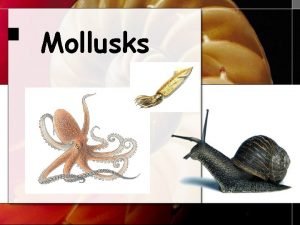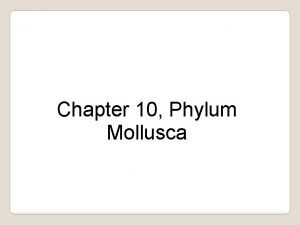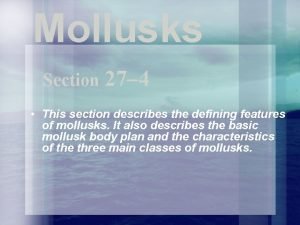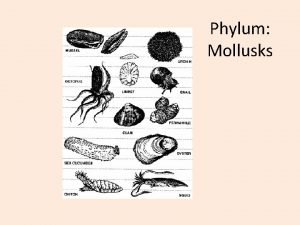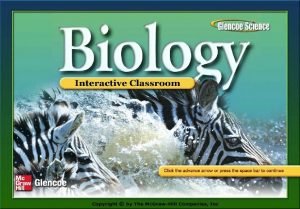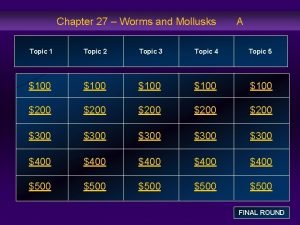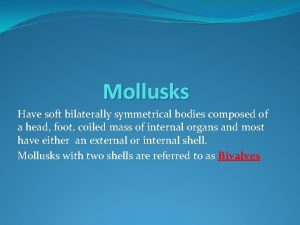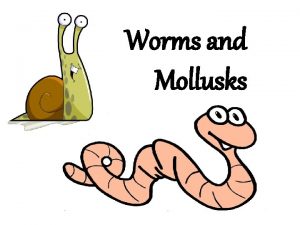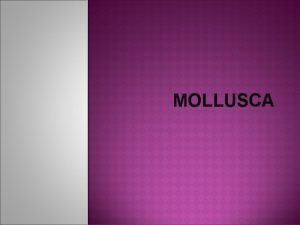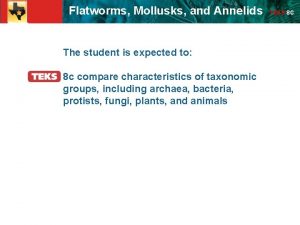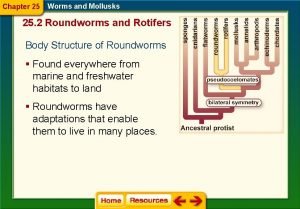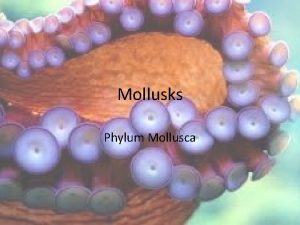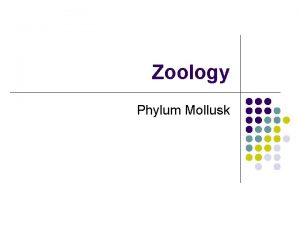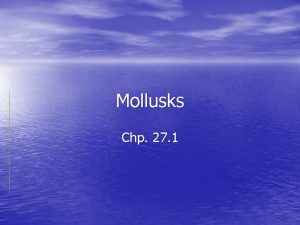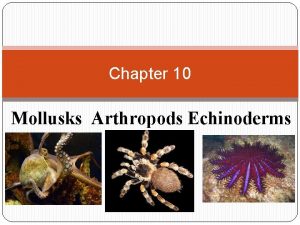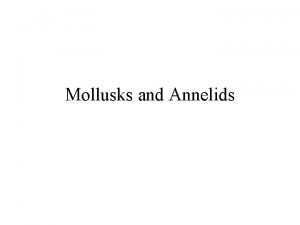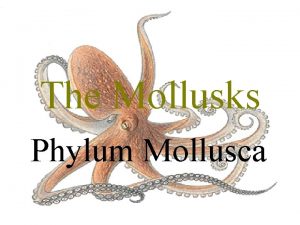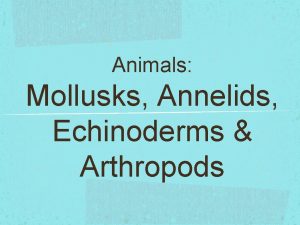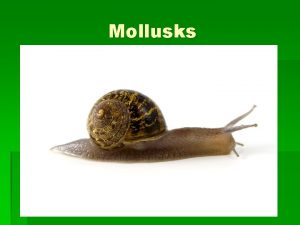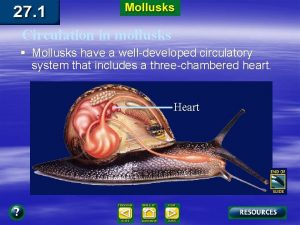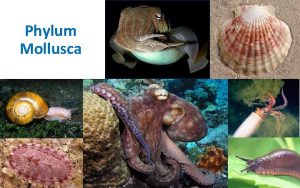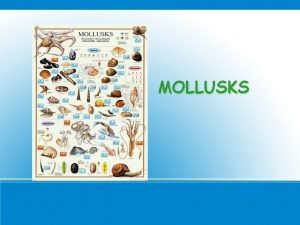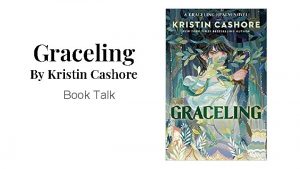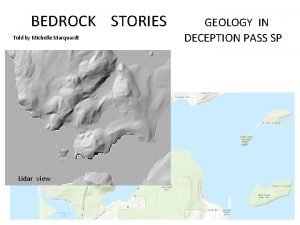Mollusks Kristin Marquardt What is a Mollusk A



















- Slides: 19

Mollusks Kristin Marquardt

What is a Mollusk? • A mollusk is a soft bodied animal of the phylum Mollusca, having an unsegmented body • Mollusks: – – Lack skeletons Soft bodies 3 -part body plan Open blood systems (Except cephalopods) – Radula (Except bivalves)

Body Plan • All mollusks have a 3 -part body plan: – Muscular foot – Head – Visceral Mass (Mantle Cavity)

Types of Mollusks • Mollusks are broken down into 3 major classes: – Bivalves (Scallop) – Gastropods (Slug) – Cephalopods (Octopus)

Bivalves • There about 10, 000 species – Oysters, scallops, shipworms • No distinct head region • 2 -part shell that is connected by a hinge and adductor muscles • 3 layers of the shell – Tough outer layer – Thick middle layer – Smooth inner layer

Eating Habits • Suck water through • Oysters permanently siphons (hollow tubes) attach to rocks to feed • The water goes in one • Scallops swim as they siphon, the gill feed, opening and catches the prey, and closing their valves the cilia directs food to rapidly like jaws the bivalves mouth. • The shipworm digests Then the extra water cellulose in wood by travels out the other protists that live inside siphon. it’s intestine


Reproduction • Sexually • Most born either male or female but some born hermaphroditic – Shed sperm and eggs into water, fertilization – Eggs develop – Free swimming trochophore larvae (marine) – Free swimming veliger


Gastropods • • • About 8, 000 species Snails and slugs Marine and Terrestrial Single shell Have a radula (tonguelike scraping organ) – Can be used to cut, scrape, or as a weapon • Most have a pair of tentacles with eyes on top.

Gastropods • Marine Gastropods – Shell can be closed like a door using a plate that pulls shell into place – Breathe with gills in the mantle cavity • Except Nudibranchs • Terrestrial Gastropods – Secrete mucus from base of foot – Cannot close shell – More active when air has higher moisture

Eating • Mostly herbivores • Use of radula – Marine gastropods scrape algae off rocks with radula • Cone shells use radula as a poison tipped harpoon, shot into their prey – Terrestrial gastropods saw off leaves with radula

Changing Body!!! • As the gastropod grows, it goes through torsion • Torsion is a 180 degree twisting of the mantle cavity during development • Gives gastropod a place to hide when threatened


Cephalopods

Cephalopods • About 600 species • Squid, Octopi, Nautiluses, and Cuttlefish • Most of body is a large head attached to tentacles • Marine • Most intelligent of all invertebrates • Most lack external shell – Nautilus • The largest eye in the world is from a giant squid

Eating! • All cephalopods are marine predators • They eat: – Fish – Crustaceans – Worms – Other Mollusks • Their tentacles have hooks or suction cups for catching their prey

Reproduction • The males sperm is stored in sacs that open into the mantle cavity • Males use a modified tentacle to take a packet of sperm from it’s mantle and into the female’s mantle • Eggs become fertilized, leave her body, and attach to rocks

Sources • http: //www. assateague. com/nt-bival. html • http: //www. butterflyrevolt. com/characteristics-ofmollusks. html • http: //www. marietta. edu/~biol/mussels/reprod. ht ml • http: //www. bumblebee. org/invertebrates/MOLLU SCA. htm • http: //news. nationalgeographic. com/news/2008/ 04/080430 -AP-new-zealand. html • Biology: Principles & Explorations (our text book)
 Blue dragon snail
Blue dragon snail Rosecrans/marquardt grade separation project
Rosecrans/marquardt grade separation project Marquardt method
Marquardt method Mollusks
Mollusks Rosario marquardt la malinche
Rosario marquardt la malinche Mark marquardt
Mark marquardt Phylum mollusca characteristics
Phylum mollusca characteristics Univalve mollusk
Univalve mollusk What is the function of a mollusk’s radula?
What is the function of a mollusk’s radula? Chapter 27 worms and mollusks
Chapter 27 worms and mollusks 4 classes of mollusks
4 classes of mollusks Radula tongue
Radula tongue Mollusks segmentation
Mollusks segmentation Vampire squid
Vampire squid The most active mollusks are the
The most active mollusks are the Are mollusks symmetrical
Are mollusks symmetrical Characteristics of roundworms
Characteristics of roundworms Symmetry in mollusca
Symmetry in mollusca Section 4 flatworms mollusks and annelids
Section 4 flatworms mollusks and annelids Chapter 25 section 4 segmented worms
Chapter 25 section 4 segmented worms



